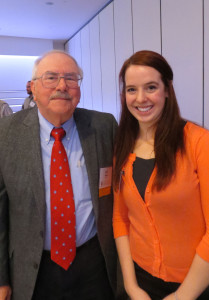Defining the Midwest Wine Tourist
There’s no denying that the Midwest wine tourism phenomena is real. Visiting a regional winery is a genuine experience that consumers, especially urban consumers, savor.
Identifying the exact appeal of a Midwest winery trip is difficult. To me, regional wine represents a reconnection to the American core values of self-reliance and self-sufficiency on a local level. A regional winery is one of the few remaining places where consumers can enjoy an artisan product and see firsthand both the people and the plants that produce it.
Now Dr. Dan McCole of Michigan State University (MSU) has completed scientific studies that bring the motives and behavior of the Midwest wine tourist into clearer focus. Before discussing the findings of Dr. McCole’s research, it’s important to note that the continuation of his work for the Northern Grapes Project depends on passage of a farm bill pending in Congress. After reading what Dr. McCole and his team at MSU have discovered, I think you will agree that his work is worthwhile.
The findings in this article are the result of multiple surveys done by Dr. McCole, Dr. Don Holocek and graduate student Anna Popp. (Popp personally conducted hundreds of interviews with tasting room visitors. We sometimes forget how much work graduate students do for very little compensation.)
One finding of the MSU research is that the primary purpose of a winery visit for almost 80% of Michigan respondents is something other than purchasing wine. In fact, the MSU studies found that the most popular reason for visiting a winery was to “have a relaxing day out.”
According to McCole, the Midwest wine tourist is not necessarily a serious wine drinker. “Midwest wineries are different and we suspect that the reasons why visitors travel to Midwest regional wine areas are different than the reasons people travel to Napa Valley or the Finger Lakes. There is a difference between a “wine drinker” and a “wine tourist” in the Midwest we believe.”
MSU’s findings contradict the popular assumption that millenialls are driving Midwest wine tourism. The largest age group for Michigan wine tourists is actually ages 51-60. Young adults were the second largest age demographic for Michigan tasting room visits.
The money being spent on Michigan wine excursions is significant, so it’s not surprising that winery visitors are older. Mc Cole found that the average amount spent during a Michigan wine trip is $780 and respondents bought an average of 7.4 bottles of wine at $16.50 a bottle.
One interesting finding of Mc Cole’s study is that people are willing to spend considerably more for a bottle of wine at a winery than at a retail store. When asked how much they typically pay per bottle for wine consumed at home, over two-thirds of respondents indicated that they spent less than $12 per bottle. However, the MSU study found that average cost of a bottle of wine purchased at a tasting room is $16.50.
McCole said that he’s not sure why people will pay more for wine at tasting rooms, but he does not think that the reason is because the wine is not available at home. “People are not always going to regional tasting rooms to purchase wine,” he said. “Based on what our respondents said, they buy wine more as a souvenir or as a way to remember the trip to the winery.”
One take away from the studies that surprised Dr. McCole is that only 7% of respondents visit wineries to learn about wine. “If people are going to wineries primarily to socialize or to have fun, then tasting rooms and wineries should be designed with this in mind; a lot of people are not visiting for wine education,” he said.
The MSU research indicates that consumers recognize ongoing improvements in Michigan wine quality. 60% of respondents felt Michigan wines were equal to or better than California wine and only 17% thought Michigan wines are inferior to California.
65% of Michigan wine consumers also said they’d tasted wines made from cold hardy grapes and 42% said they like cold hardy varietals “a lot.” However, cold climate wine name recognition is very low. Edelweiss was tops in hybrid grape familiarity with respondents, but only 17% recognized the varietal.
The MSU studies underscore the challenge cold hardy grapes face with name recognition. A ficticious grape, “Snow Bird,” was inserted into the MSU survey question which asked consumers what cold hardy grapes they’d heard of. The imaginary “Snow Bird” had better name recognition than Brianna, La Crescent, St. Pepin or LaCrosse which have all been on the market for years.
Other findings of Mc Cole’s work for Michigan State and the Northern Grapes Project:
- The average age for a Michigan tasting room visitor was 47 and 30% had been to wineries more than 21 times. 23% had visited wineries outside the U.S.
- 69% of Michigan wine tourists are from Michigan, the next state behind Michigan was Illinois at 8%.
- The economic impact of regional wine becomes apparent when respondents were asked, “How Important was visiting a winery/wineries to your decision to travel to the area?” 73% said that visiting a winery was at least “somewhat important” in their decision to travel to the area. 18% said wineries were the only reason they were visiting the area.
- Two thirds of people started planning at least one month before their wine trip. Fifty percent use the internet to plan their trips.
See Related Story: Michigan Wine is Now Pure Michigan






OK let’s call the next grape out of University of MN, “Snow Bird”!
Very good article! It brings a smile to my face to see effort being put into research on the tourism aspects of regional wine. With the first-ever, Wine Tourism Day in North America, fast approaching on May 11th, it’s nice to see momentum building in the “other wine regions” of our country. I think that, in many ways, Americans are accustomed to getting their wine information from California. With the concept of locavore continuing to gain popularity, folks are beginning to realize that they might just have a knowledgeable authority on wine in their own back yard, at one of their local wineries. They can enjoy some great wines and experience the people and places who produced them, all while supporting their local economy!
Frank Malley
Northcoast Grapevine Tours
Lorain, Ohio
This is exactly what I’m seeing in my Lake Geneva tasting room. We thought we would have younger visitors, but they are for the most part 45 -65 just out to have some fun. What a great job, waiting on people that want to have fun and pouring it for them : )
Kathy Jackson
Studio Winery
Lake Geneva, WI
Thanks for dispelling some baby boomer myths. There’s a lot of middle aged folks who are looking for new experiences and are willing to try new wines.
My wife and I along with another married couple have been doing winery tours since 2004. We visit a wine growing region in various states one week each year. We have visited Missouri (along the Missouri river, Missouri (Southeast), Door county Wisconsin, Southern Illinois, Southern Indiana, Traverse City Michigan, Southwest Michigan, and Cincinnati Ohio. We usually visit around 20-25 wineries per trip. All of us are in our early 60’s and do our wine trips more or less as a hobby. We are all wine lovers and are very well educated in regards to varietals. Our main purpose in tasting is to buy and transport back home to Northern Illinois for future consumption .I would say that we purchase at least on bottle per couple (2) at least 95% of the time. Unfortunately, the tasting fees are beginning to price us out of the market. It’s getting to the point where we may only visit wineries with no or smaller fees. We fully appreciate the fact that wineries give out a lot of samples to people who have no intention of buying and have to recoup the cost. We don’t mind the fee if it is waved with purchase. I don’t want to see local wineries priced out of the market. I can buy a good bottle of Riesling from California or Germany at the local store for $12. If I go to a local winery, the cost is $15 plus say a $7 tasting fee for a total of $22. Where’s my incentive to visit and buy local???
Thanks for your support of Midwest wine! Wineries should apply tasting fees to purchases. Some states now require tasting fees. However, some people think that not charging a tasting fee results in more sales for the winery because customers feel an obligation to reciprocate for the “free” wine.